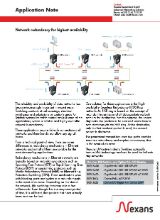- About Aginode
- Data Networks
- Telecom Infrastructure
- Products
-
Resources
- Resources
- Documentation
- Blog
-
Case Studies
- Overview
- Innoasis development in Norway
- Eemsdelta Campus
- Hotelschool The Hague
- Emergency covid hospital, Hong Kong
- Société du Grand Paris
- Centrin Datacentres
- Airbus
- Athens Historic City Hall
- Pinewood Studios
- Goethe University Frankfurt
- Denmark New University Hospital
- University of Toulouse
- CHM Maubeuge: a model for future-ready hospitals
- Webinars
- Software Tools
- Warranty
- Newsroom
- Search
- Contact us
- Compare
- Sign in
Industrial
Are you thinking about network redundancy?


How a fibre optic cable created chaos at London Gatwick airport
Have you ever been at an airport and tried to find your gate number or flight schedule without the help of the airport’s digital monitors, website or the app on your smart phone? Chances are high you consulted all the above if you have been at London Gatwick airport last summer. Gatwick is the UK’s second busiest airport and served over 45.6 million passengers in 2017.
In the summer of 2018 its departure board systems went down, causing chaos and forcing staff to share flight information using white boards and megaphones. The airport website was also unavailable, but no flights were canceled. The outage was blamed on a damaged fibre optic network cable which lasted for eight hours.
Could this have been avoided? Possibly. But for that you need to have a data network in place that is both redundant and resilient.
Network redundancy: your plan B
Redundancy means a duplication of the critical parts of a network and its unique, specific design. A truly redundant network should be equipped with two or more fibre links, two or more central distributors, two or more network equipment modules and so on. This type of network should be designed to ensure that there are no bottlenecks in redundancy – that means ensuring there is a properly designed network topology, and that fibre links are installed using different roots, making sure you don’t use the same entry point into a building for both redundant fibre links, as well as further considerations.
Network resiliency
However, simply duplicating equipment and proprietary design isn’t a guarantee. We should also think about network resiliency – the network’s ability to reconfigure and return to normal operation in the event of failure. Standardisation bodies IEEE and IEC have developed protocols to make network redundancy functionalities available for office and industrial networks.
With the Parallel Redundancy Protocol (PRP) and High-availability Seamless Redundancy (HSR) protocols, two redundancy procedures have been developed that significantly improve the availability and error protection of network connections.
An airport infrastructure including other industrial applications like for example highway traffic control, tunnel infrastructures, IP video monitoring and security applications have become very complex and require a high level of automation and remote management. This allows optimization of infrastructures at such sites, making them more efficient, more reliable and significantly reduce downtime. All of this requires using an Ethernet network as the foundation for almost all processes. As the solution for such critical applications, many related standards require using HSR and PRP protocols.
However, in practice, the perfect network topology that covers all application area and requirements probably does not exist. The right choice of topology and Protocol always depends on additional Factors such as physical Installation instructions and the Requirements of the application.
Nexans produces a wide range of Industrial Ethernet switches and accessories which are standard compliant. These are part of the LANactive Industry solution portfolio, designed to build reliable, secure and highly available networks for mission critical applications.
Documentation
Categories
Our websites
Select your country to find our products and solutions
-
Africa
- Africa
- Ghana
- Ivory Coast
- Morocco
- North West Africa
- Americas
- Asia
- Europe
- Oceania

